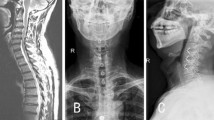Abstract
No previous studies have reported 10-year follow-up results for double-door laminoplasty using hydroxyapatite (HA) spacers. The purpose of this study was therefore to explore the long-term results of double-door laminoplasty using HA spacers and to determine if non-union or breakage of HA spacers is related to restenosis of the enlarged cervical canal. The study group consisted of 68 patients with a minimum of 10 years of follow-up after double-door laminoplasty using HA spacers. The average postoperative Japanese Orthopaedic Association score improved significantly after surgery and was maintained until the final follow-up. The average range of motion decreased by 42.6% in patients with cervical spondylotic myelopathy (CSM) and 65.8% in patients with ossification of the posterior longitudinal ligament (OPLL). The enlarged cervical canal area was preserved almost until the final follow-up. The average non-union rates of HA spacers were 21% in CSM and 17% in OPLL, and the average breakage rates were 24 in CSM and 21% in OPLL at the final follow-up. Although non-union and breakage of HA spacers were common, neither of these factors were correlated with restenosis of the enlarged cervical canal.





Similar content being viewed by others
References
Chiba K, Ogawa Y, Ishii K et al (2006) Long-term results of expansive open-door laminoplasty for cervical myelopathy—average 14-year follow-up study. Spine 31:2998–3005
Seichi A, Takeshita K, Ohishi I et al (2001) Long-term results of double-door laminoplasty for cervical stenotic myelopathy. Spine 26:479–487
Nakano K, Harata S, Suetsuna F et al (1992) Spinous process-splitting laminoplasty using hydroxyapatite spinous process spacer. Spine 17(Suppl 3):S41–S43
Tsuzuki N (1997) A novel technique for laminoplasty augmentation of spinal canal area using titanium miniplate stabilization: a computerized morphometric analysis. Spine 22:926–927
Martin-Benlloch JA, Maruenda-Paulino JI, Barra-Pla A et al (2003) Expansive laminoplasty as a method for managing cervical multilevel spondylotic myelopathy. Spine 28:680–684
Hosono N, Sakaura H, Mukai Y et al (2007) The source of axial pain after cervical laminoplasty—C7 is more crucial than deep extensor muscles. Spine 32:2985–2988
Kotani Y, Abumi K, Ito M et al (2009) Minimum 2-year outcome of cervical laminoplasty with deep extensor muscle-preserving approach: impact on cervical spine function and quality of life. Eur Spine J 18:663–671
Iwasaki M, Kawaguchi Y, Kimura T et al (2002) Long-term results of expansive laminoplasty for ossification of the posterior longitudinal ligament of the cervical spine: more than 10 years follow up. J Neurosurg 96(Suppl 2):180–189
Kawaguchi Y, Kanamori M, Ishihara H et al (2003) Minimum 10-year follow-up after en bloc cervical laminoplasty. Clin Orthop Relat Res 411:129–139
Iizuka H, Nakagawa Y, Shimegi A et al (2005) Clinical results after cervical laminoplasty: differences due to the duration of wearing a cervical collar. J Spinal Disord Tech 18:489–491
Takeuchi K, Yokoyama T, Ono A et al (2007) Cervical range of motion and alignment after laminoplasty preserving or reattaching the semispinalis cervicis inserted into axis. J Spinal Disord Tech 20:571–576
Roselli R, Pompucci A, Formica F et al (2000) Open-door laminoplasty for cervical stenotic myelopathy: surgical technique and neurophysiological monitoring. J Neurosurg 92:38–43
Takeuchi K, Yokoyama T, Ono A et al (2008) Limitation of activities of daily living accompanying reduced neck mobility after laminoplasty preserving or reattaching the semispinalis cervicis into axis. Eur Spine J 17:415–420
Yu HL, Xiang LB, Liu J et al (2010) Laminoplasty using Twinfix suture anchors to maintain cervical canal expansion. Eur Spine J 19:1795–1798
Hori T, Kawaguchi Y, Kimura T (2006) How does the ossification area of the posterior longitudinal ligament progress after cervical laminoplasty? Spine 31:2807–2812
Kaito T, Hosono N, Makino T et al (2009) Postoperative displacement of hydroxyapatite spacers implanted during double-door laminoplasty. J Neurosurg Spine 10:551–556
Kanemura A, Doita M, Iguchi T et al (2008) Delayed dural laceration by hydroxyapatite spacer causing tetraparesis following double-door laminoplasty. J Neurosurg Spine 8:121–128
Conflict of interest
None.
Author information
Authors and Affiliations
Corresponding author
Rights and permissions
About this article
Cite this article
Kimura, A., Seichi, A., Inoue, H. et al. Long-term results of double-door laminoplasty using hydroxyapatite spacers in patients with compressive cervical myelopathy. Eur Spine J 20, 1560–1566 (2011). https://doi.org/10.1007/s00586-011-1724-7
Received:
Revised:
Accepted:
Published:
Issue Date:
DOI: https://doi.org/10.1007/s00586-011-1724-7




